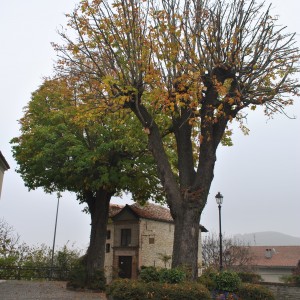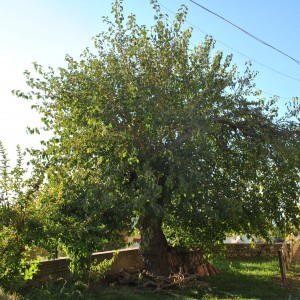St. Baptist John’s church

St. Baptist John is the most ancient church of Alba only after St. Lawrence’s Cathedral and Santa Maria Del Ponte, which is now disappeared. This church gave its name to the third neighborhood of the city, as it is well documented at the number CCCXI of the medieval “Rigestum Comunis Albae”. The coeval codex of Alerino dei Rembaudi confirms that San Giovanni Church has the same age of San Lorenzo Cathedral. Its original shapes can only be recognized from the few existent representations (a drawing on table from the sixteenth century, the Theatrum Sabaudie, some drawings of C. Rovere and some old photographs) and from the archive documents.
In 1556 the church and part of the surrounding buildings were given to the Augustinian priests, whose monastery located beyond the spinning structure and near S. Maria della Consolazione Church was destroyed during the wars between France and Spain. In 1700 a magnetic compass was added to the bell tower and provided with a clock that, during the Napoleonic invasion, was transferred to the bell tower of San Damiano Church; its façade was beautified, some artworks were added to the church and the colonnade was erected on the south side of it. After the Napoleonic invasion, the Augustinians abandoned the church, which became a warehouse.
Michele Travaglio became parish priest of the Church in 1819, during the same year of its restoration, and he tried in different ways (even by begging the King) to bring the cure of the souls back in San Giovanni and to redecorate the church in the best way as possible because it was unstable and lacking of every kind of furniture. Different holy furniture and artworks were recovered from the demolished church of San Francesco.
His successors tried to beautify the church; for example in 1830 the choir was rebuilt, in 1834 the façade was renovated and in 1876 the brothers Vittino di Centallo put a new organ on the platform. In 1884 the canonical Nicolao Strumia raised the church of 4 meters and built a new façade and the paneled ceiling still present today from the drawing of the engineer Fantazzini from Turin.
In the last decades the structure of the church and its furniture remained unchanged excluding the presbytery reconstruction, the renovation of the floor and the heating system and finally the recent and important renovation works realized on the church and on the rectory by the current priest Renato Gallo.
Artworks
Even though only few parts survived from the ancient medieval building, the ancient artworks hosted there are various and even precious. Fragments of frescoes are on the wall of the counter façade, hidden by the platform of the organ. They show some feminine shapes kneeled down to prey and two San Giovanni (The Evangelist and The Baptist). Concerning the style, they recall the French painting: in particular they are similar to some works of the Master of Nicola, operating in Savigliano.
The first chapel on the right hosts the baptistery. As the inscription on the wall remembers, its current aspect dates back to 1939, when the architect from Alba Giovanni Oreste Dellapiana intervened. On the inside there is the marble baptismal font and, on the wall, a sculptural terracotta group showing the baptism of Christ and realized by Virgilio Audagna (1903-1995) from Turin.
In the third chapel an interesting renaissance table shows Virgin Mary with the child between the Saints Agostino and Lucia; this work was commissioned by the Counts Verri della Bosia, patrons of the altar, to an unknown artist of the beginning of the sixteenth century. The painting is considered influenced by the school of Macrino for its characteristics.
In the chapel once dedicated to Saint Onorato and property of the Society of Silk Workers (which was strictly connected to this church because the market of cocoons and silkworms had place in the square in front of the church) an image of the protector was positioned in 1822: San Giobbe in disgrace, realized by the painter Giuseppe Chiantore (1747-1824) from Savigliano. The painting was restored in 2006.
In the presbytery rebuilt since 1830 there’s the major altar, realized in 1894 by Cesare Fantazzini. Over the altar there are five tables painted with tempera attributed for certain to the painter Gandolfino da Roreto from Asti (documented between 1493 and 1518). These little paintings might have been part of the predella of a great polyptych signed by Gandolfino, dated 1493 and now kept in the Sabauda Gallery of Turin. This artwork, that originally was located in St. Francis’ Church in Alba, was taken away after the demolition of the building and given (excluding the predella) from the bishop Michele Fea to the royal collections of Turin in 1837.
On the right of the altar, against the wall, there’s a bench realized with some fragments coming from an ancient wood choir, originally located in St. Francis’s Church and then dismembered. Thanks to what has been reported by the researcher Giuseppe Vernazza from Alba, who saw it when it was still entire, we know that it has been realized in 1429 by Urbanino da Surso (c.1480-l461/63) from Pavia, under commission of the parish Marco from Sommariva.
Over the bench there’s a beautiful eighteenth-century painting where the Virgin Mary is represented with the child, St. John, God, the Holy Spirit and St. Julius del Taricco.
On the back wall of the church, one can observe the frescoed triptych of Paolo Gaidano, a painter coming from Poirino who realized this in 1887: at the centre the Virgin Mary with the child between St. Therese d’Avila and St. Francis and at both sides two little angels.
Under the triptych there’s The Baptism of Christ, a beautiful painting painted by Giovanni Antonio Molineri (1577-1631) during the last years of his life.
In the presbytery, on the left wall, there’s the great painting Madonna del Carmine, originally located in the chapel with the same name. It has been attributed to Guglielmo Caccia called “Moncalvo” because of the strong similarity with some of his works that had a similar subject; today it is considered as a work realized by an anonymous follower of the artist.
In the chapel today become the access for the rooms of the rectory there’s an interesting painting arrived at St. John’s Church after a donation made in 1992. The painting shows St. Baptist John in the desert and an angel and it is attributed to Giuseppe Doneda (or Danedi) called “Montalto” (1609 – ca. 1678-1679).
On the wall in front of the chapel there’s the painting showing Emmaus’ Dinner with the characteristic iconography influenced by Caravaggio. The painting, signed GAM and dated 1629, can be attributed or referred to the already mentioned painter Giovanni Antonio Molineri.
In the first chapel on the left there’s the precious table showing the Virgin Mary with the child signed and dated by Barnaba da Modena in 1377. Barnaba, documented between 1361 and 1383, grew in the Emilian environment and has archaic and byzantine traits.
Opening Timetable
St. Baptist John’s Church is located in Piazza Pertinace 4, in Alba (Cuneo). The church can be visited everyday excluding during religious celebrations (8.00;18.00).






